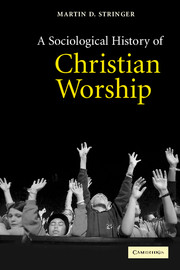Book contents
- Frontmatter
- Contents
- Preface and acknowledgements
- Introduction: Discourse, devotion and embodiment
- 1 Early Christian worship, texts and contexts to ad 300
- 2 Worship and the Christianisation of public space, 300–600
- 3 Hegemonic discourses in the worship of empires, 600–900
- 4 The dominant discourse of cosmological Christianity, 900–1200
- 5 Accessing the demotic discourses of devotion, 1200–1500
- 6 Worship and the rise of humanistic discourses, 1500–1800
- 7 The globalisation of Christian worship, 1800–2000
- Bibliography
- Index
7 - The globalisation of Christian worship, 1800–2000
Published online by Cambridge University Press: 03 December 2009
- Frontmatter
- Contents
- Preface and acknowledgements
- Introduction: Discourse, devotion and embodiment
- 1 Early Christian worship, texts and contexts to ad 300
- 2 Worship and the Christianisation of public space, 300–600
- 3 Hegemonic discourses in the worship of empires, 600–900
- 4 The dominant discourse of cosmological Christianity, 900–1200
- 5 Accessing the demotic discourses of devotion, 1200–1500
- 6 Worship and the rise of humanistic discourses, 1500–1800
- 7 The globalisation of Christian worship, 1800–2000
- Bibliography
- Index
Summary
INTRODUCTION: GLOBALISATION
This chapter represents the last two hundred years of Christian history with the spread of Christianity to every corner of the world. This is not to say that Christianity had never been an international, or even global, religion before; it simply recognises a new phase in its global spread. Part of this new phase simply acknowledges the extent of the global spread, but more importantly, and picking up ideas from previous chapters, it recognises a new relationship with other religious traditions and discourses. This puts the last two hundred years into a different context from much of what has gone before.
In talking about the way in which Christianity became global, and the impact that this had on worship, we must explore the idea of globalisation. Peter Beyer identifies four features of recent theories of globalisation that are specifically relevant to the discussions in this chapter. The first is the importance of mass communication. What is new about the world we now live in is that events and ideas can be spread around the world practically instantaneously and that developments in one part of the world, especially of an academic nature, inevitably affect developments in all other places. We are part of a single conversation, if not a single discourse. This can be seen, in terms of Christian worship, with the revisions of the liturgy that affected all the principal churches in the second half of the twentieth century.
- Type
- Chapter
- Information
- A Sociological History of Christian Worship , pp. 209 - 239Publisher: Cambridge University PressPrint publication year: 2005



